IT Program Management Office
On this page
{:.no_toc .hidden-md .hidden-lg}
- TOC {:toc .hidden-md .hidden-lg}
Quick Links
IT PMO Team
We are a global team of five, focused on building and managing world-class information technology systems and business processes. To learn more about our individual job functions, visit the Program Management, Business Technology family page.
Barbara Roncato - Manager, IT Program Management
GitLab handle: @broncato
Slack handle: @barbara
Location and Timezone: Portugal, WEST/GMT+1
LinkedIn Profile: /roncatobarbara
Caroline Swanson - Senior IT Program Manager
GitLab handle: @caroline.swanson
Slack handle: @Caroline Swanson
Location and Timezone: USA, MDT/MST
LinkedIn Profile: /caroline-smoke-swanson-pmp-a869b685
Kayoko Cooper - Business Systems Analyst
GitLab handle: @kayokocooper
Slack handle: @Kayoko Cooper
Location and Timezone: USA, EDT/EST
LinkedIn Profile: /kayoko-cooper-a1063522
Kristina Koceban - Senior Business Systems Analyst
GitLab handle: @kkoceban
Slack handle: @Kristina
Location and Timezone: Ireland, WEST/GMT+1
LinkedIn Profile: /kristinakoceban
Nico Sandoval - Business Systems Analyst
GitLab handle: @nicosando
Slack handle: @Nico Sandoval
Location and Timezone: USA, EDT/EST
LinkedIn Profile: /nicolas-sandoval-331900b3
Our Mission
The IT Program Management Office (PMO) mission is to provide:
- A standard approach to project delivery across the IT department
- Full and accurate visibility of IT project status
- Effective prioritization of project management resources to support all IT initiatives
What We Do
IT Portfolio Planning & Prioritization

The IT portfolio planning & prioritization process has 6 steps:
- Portfolio of Projects
- Prioritization
- Resources & Capacity Planning
- Project Commits
- T-Shirt Sizing
- Alignment & OKRs
IT Portfolio of Projects
The inventory of all committed and planned projects for the quarter in IT Operations and Enterprise Applications. The IT Portfolio: Quarterly Commits is available for internal team members to track IT planned initiatives. All projects on the IT Portfolio have a Team & Corporate Stack Ranke to align with the overall global optimization.
IT Project Prioritization
The IT Project Prioritization tracker is used to log new projects / initiatives with the IT team. The IT PMO team will review it as part of the IT Quarterly Portfolio Planning:
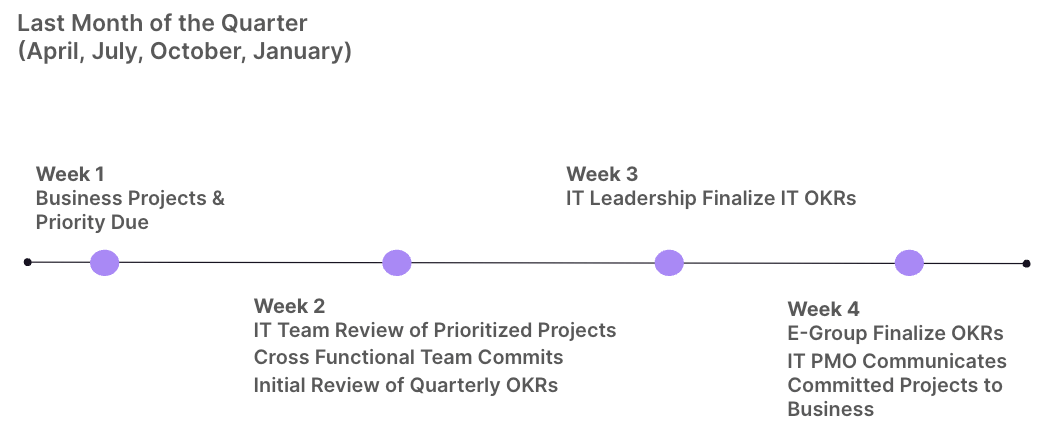
Resources & Capacity Planning
Achieved by:
- Identifying all resource on the team
- Estimating capacity like Keeping the lights on (KTLO), Admin, Management and Projects
Project Commits
All projects added to the IT Portfolio: Quarterly Commits have:
- Resources assigned in order of priority
- An appropriated label:
- Committed: Projects that are in-flight / being worked on
- Planned: Projects that will be picked up once the resources from a committed project becomes available
- Backlog: Projects that are in the pipeline but not yet ready to start
T-Shirt Sizing
Consists in identifying the project’s:
- Estimated Level Of Effort (LOE)
- Duration
- Roles & Responsibilities
Alignment & OKRs
All projects added to the IT Portfolio: Quarterly Commits are part of the Business Technology OKRs for:
- Awareness
- Accountability
- Value Generation
Release Management
The release management plan helps the IT team:
- Set an agreed upon standard
- Operationalize
- Keep consistency & predictability
- Communicate changes regularly and transparently
Release Calendar
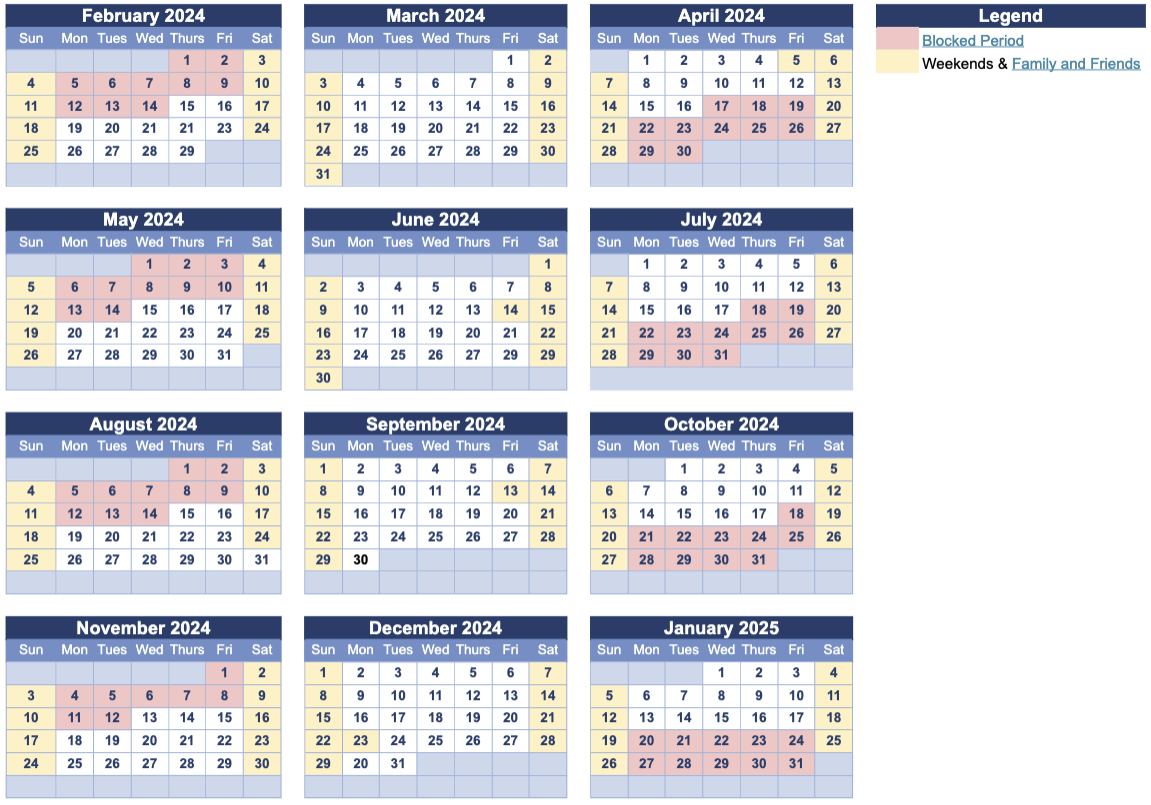
How We Work
Governance and Program Management Methodology
Visit the Governance and IT Program Management page to understand the methodology adopted by the IT PMO team for all GitLab IT programs aimed at achieving the following objectives:
- Ensuring robust results and efficient execution.
- Ensuring proper scoping aligned with our value of iteration.
- Engaging appropriate stakeholders in line with our value of collaboration.
- Maintaining proper documentation for compliance, consistent with our transparency value.
IT PMO Intake Process
Every week, the IT PMO Management team review the IT-Intake-PMO board, with only a single outcome for the issues listed under the Open list:
- The issue is related to an ongoing project from the IT Portfolio of Projects and it will be picked up by the IT Program Manager that is assigned to the project.
- IT PMO will add the appropriated team label and work with the business requestor to get all necessary information so the issue can be placed into the appropriated EntApps Milestone.
- The issue is not related to an ongoing project from the IT Portfolio of Projects and so it will be placed in the backlog in the IT Prioritization tracker. The IT Prioritization tracker is reviewed during the IT Portfolio Review (monthly) meeting
- The it-pmo-backlog label will be added.
Project Epics & Issues
When assigned to a project, the IT PMO team is responsible for creating and maintaining the project Epic. A single parent Epic is created together with (up to) 5 child Epics, each representing a distinct phase of the System Development Lifecycle (SDLC). Issues are used as a means to collaborate on ideas, troubleshoot problems, and strategize for their tasks. By using issues, teams can share and discuss proposals internally or involve external collaborators in the process.
To maintain uniformity across all PMO-led projects, the team follows the same Epic templates.
System Development Lifecycle (SDLC)
The System Development Lifecycle outlines a structured set of activities conducted at each project stage.

Intake
The intake process starts with the completion of a business requirements document. It is the bridge between business stakeholders defining what is to be worked on and the development group that will build it.
Define
During Define, the project team articulates the business problem and definition of done. This phase covers uses cases, technology impacted and requirements. The ultimate goal of Define is not to figure out everything but to document the process and what is impacted. Finally, before beginning the design, we request approval sign-off from key stakeholders to ensure business requirements are accurate and all-inclusive.
Design
This phase creates the roadmap of how things will work in the future. The project team work with the business to design a future state process and refine the requirements to build it. This phase should iron out all the details and questions from above.
Build
In the Build phase, the project team collaborates with other stakeholders to develop solutions that meet the business requirements but also that are scalable and aligned with best-practices.
Test
During the test phase, the project team collaborates with other stakeholders to develop test scripts and facilitates the user acceptance testing (UAT) process.
Deploy
The project team owns developing a deployment plan and collaborating with other implementation teams to ensure completeness. This involves launch plans, user enablement, and go-live communications.
Hypercare
Hypercare is the period that immediately follows the deployment / launch of a new process in Production where an elevated level of support is available to ensure the seamless adoption of a new system.
Maintenance
The maintenance phase occurs once the new process is fully operational to ensure it continues to function as it was designed to, and repairs or upgrades are performed as needed.
Roadmap
In order to track the progress of each program efficiently, all Epics are assigned a Start and End dates, and the GitLab Roadmap is used as a timeline.
Issue Boards
The IT teams use issue boards in GitLab to strategically plan, organize, and visualize their work managed through GitLab issues. To understand how IT teams organize and manage their issue boards, visit each team’s respective page.
Labels
The IT teams use labels to categorize issues and epics effectively. By maintaining a concise list of labels, teams can efficiently organize and tag their work, enabling dynamic filtering and streamlined management of epics and issues. All labels are created in the gitlab.com/gitlab-com top-level group so they can be applied to any projects that we work on.
To better organize and manage their work, the IT teams have different label categories. Click on each category to view the current labels utilized by the IT teams:
- Priority labels
- Team labels
- Status labels
- Project labels
- System labels
- Service Desk labels
- Intake labels
Project Reporting
- The IT PMO team uses the Rolly Bot, a tool created by the IT Integrations team aimed at automating the generation and distribution of weekly status updates. Every Friday, the PMO updates the Rolly section of each project Epic (that they are assigned to) to deliver consistent updates on ongoing projects.
- A new roll up is created every Monday.
- Asynchronous updates of the program are communicated through the dedicated program Slack channel, using Geekbot.
- For more extensive programs, the IT PMO team may generate a Weekly Status Report intended for distribution among the program team and is frequently reviewed during the weekly program status meetings.
Compliance Documentation
The IT PMO team supports project stakeholders in gathering all the essential information required for SOX (Sarbanes-Oxley Act) and compliance purposes throughout the project’s lifecycle. We have developed multiple templates following the guidelines provided by the IT Compliance team. These templates aid in creating comprehensive and well-structured documentation, facilitating the gathering of essential information.
The IT PMO team collaborates with project stakeholders to create these documents and ensures that all necessary approvals are captured within them.
Enablement Plan
The IT PMO team takes the lead in initiating discussions regarding enablement and collaborates with the project lead to develop training materials and communication plans, as required.
IT Quarter Planning Process
There are several activities that take place to prepare for new OKRs / commits and report on the current ones:
-
Project List & Priorities from Business: The IT PMO team reaches out to Business stakeholders to get a list of projects and priorities for the upcoming quarter.
-
Update OKR(s) progress: The IT PMO works with IT Leadership to update the OKR(s) progress in gitlab.com.
-
IT PMO & Leadership - Upcoming Quarter Priorities Review: The IT PMO team reviews the business projects and priorities with IT Leadership to add initiatives to the upcoming commits tracker.
-
Quarter Commits - Corporate Rank: The IT Leadership works with the business leaders to rank the initiatives in order of priority for the company.
-
Cross Functional Meeting - Quarter Commits Review: IT PMO team hosts the
IT Portfolio: Quarter Planningmeetings to review the list of projects and priorities for the upcoming quarter with the Business stakeholders. -
IT PMO - Quarter Commits (Adjustments): The IT PMO team makes all the necessary adjustments to the upcoming quarter commits following the meeting with the Business stakeholders.
-
IT Leadership - Quarter Commits (Adjustments): The IT Leadership team makes all the necessary adjustments to the upcoming quarter commits following the updates from the Corporate stakeholders.
-
Upcoming Quarter Commits Shared with the Business: The IT PMO team shares the upcoming quarter commits with the Business stakeholders.
-
Finalize Upcoming Quarter OKR(s): Upcoming quarter commits are completed.
-
IT All Hands Quarterly Meeting: The IT Leadership hosts the Quarterly IT All Hands.
FY25 Q1 Calendar
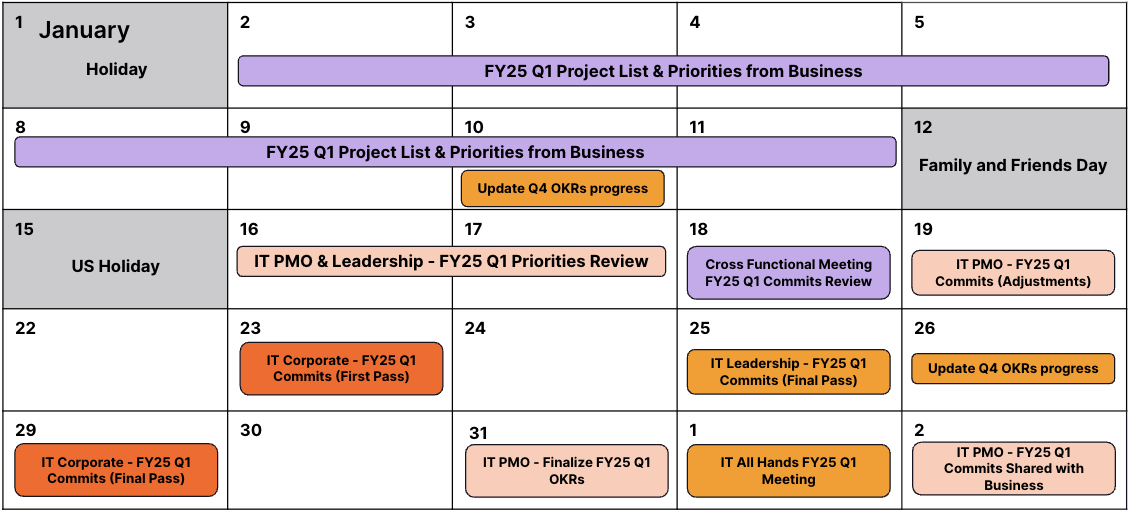
FY25 Q2 Calendar
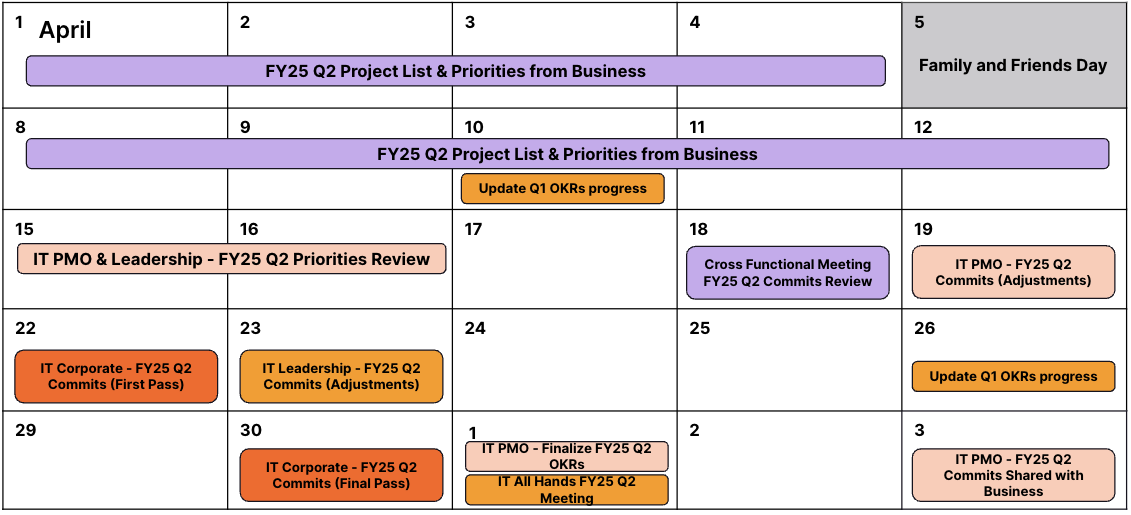
FY25 Q3 Calendar
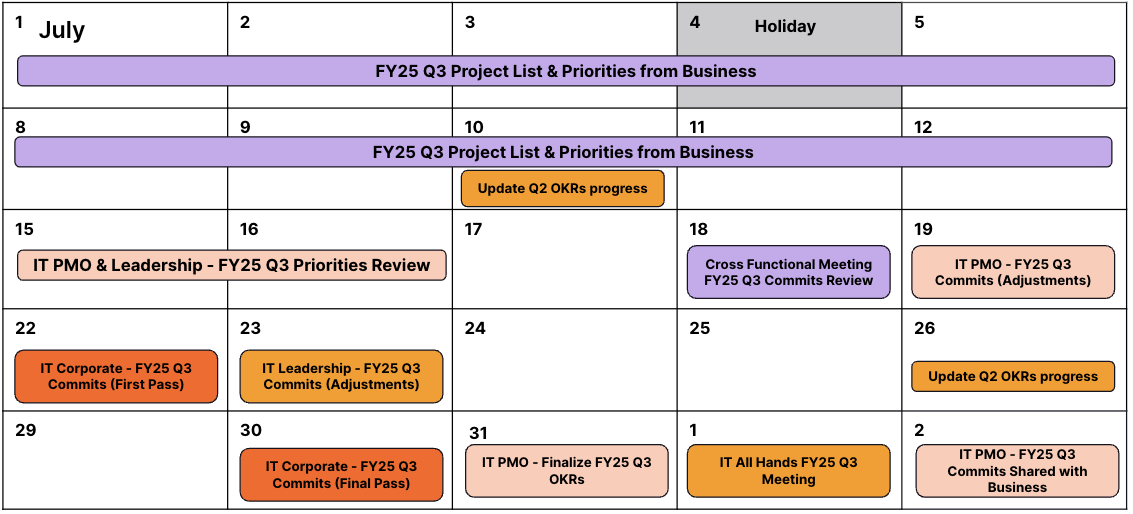
FY25 Q4 Calendar
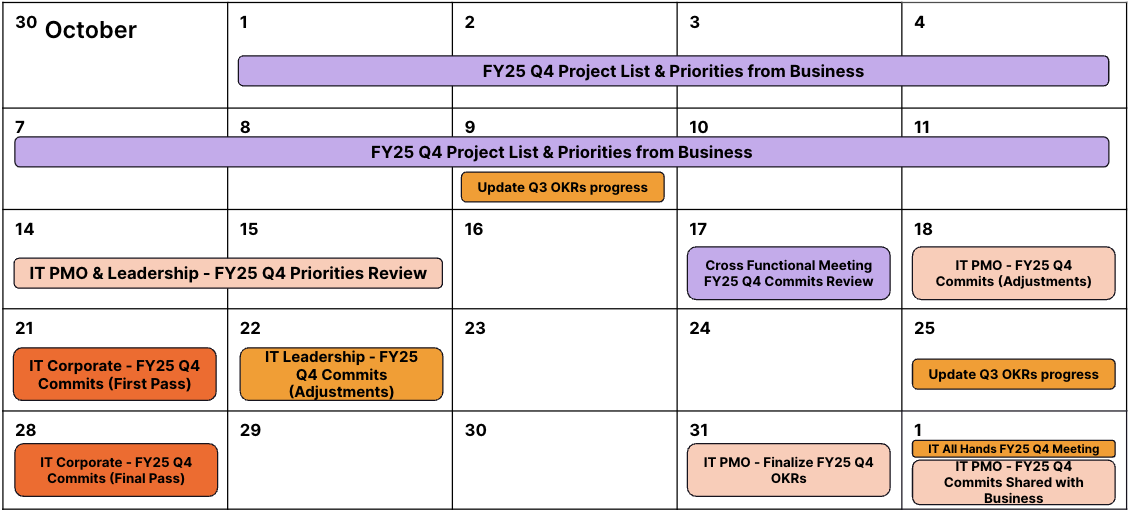
Weekly Roll Up Reporting
The IT Integrations team designed the Rolly Bot, a tool aimed at automating the generation and distribution of weekly status updates. With this tool, the IT PMO Team can deliver consistent updates on ongoing projects. A new roll-up is produced every Monday.
Definitions and terms used across the IT department
- Service Desk: Single point of contact between IT service providers and users/customers. The primary goal of the Service Desk is to ensure that all incidents, service requests, and other IT-related issues are promptly addressed and resolved, ensuring minimal disruption to the business.
- Continual Service Improvement (CSI): An ongoing process that focuses on improving the quality of services and the efficiency of IT processes. It involves identifying areas for improvement, implementing changes, and measuring the results.
- Service Request, Change request and Incident: three distinct concepts that play essential roles in IT Service Management. Here are the key differences between them:
| Concept | Definition | Purpose | Examples |
|---|---|---|---|
| Service Request | A service request is a formal request from a user or customer for information, advice, a standard change, or access to an IT service. It involves predefined and well-documented procedures. | Service requests are typically routine, low-risk, and straightforward tasks that do not require major changes to the IT environment. They aim to fulfill specific user needs and provide predefined services quickly and efficiently. | Password reset, user account creation, software installation, email account setup, hardware procurement, conference room booking, etc. |
| Change Request | A change request is a formal proposal to modify the configuration of an IT service, system, or infrastructure in a controlled manner. It aims to introduce improvements, fix issues, implement new features, or make any other alterations that can potentially impact the existing environment. | Change requests involve making intentional changes to the IT environment, and they need to be carefully evaluated, planned, and implemented to avoid disruptions and minimize risks. Change management ensures that changes are controlled and align with business objectives. | Software upgrade, hardware replacement, infrastructure configuration change, service maintenance window, database schema modification, etc. |
| Incident | An incident is an unplanned interruption or reduction in the quality of an IT service. It can also refer to the failure of a configuration item (CI) that has not yet impacted service but poses a significant risk of doing so in the future. | Incidents are unexpected events that disrupt normal service operations and require immediate attention to restore service to its normal state. Incident management focuses on minimizing the impact of incidents on users and business operations. | Network outage, application crash, server failure, data loss, email delivery problems, etc. |
- Project: To be considered a project the request need to meet all the below criteria:
- The work will taken more than 48hrs to be built and tested (end to end)
- Involves 2 or more systems
- Involves 2 or more stakeholders
- Involves 2 or more teams (even within IT so for example, EntApps LTC and EntApps Integrations)
The main difference between a project and a change request in ITIL lies in their scope, nature, and the processes they follow. Projects are temporary, comprehensive efforts aimed at achieving specific goals, while change requests are smaller, routine or ad-hoc requests to modify existing IT services or configurations.
Meetings
Meetings Protocol
The team follows GitLab meeting practices and standards.
- Every meeting has an agenda.
- All agendas are stored in the PMO Team Meetings shared drive.
- The IT PMO team lead all meetings related to projects.
IT Governance
IT Leadership Meeting
- Purpose: Every week the IT Leadership team has a dedicated time to sync up and discuss current activities (urgent and important) that impacts the whole team.
- Frequency: Weekly, on Thursdays
- The time of this meeting may vary to accommodate the different timezones of the IT / Business Technology team members.
- Participants: VP, IT (host), IT PMO, Enterprise Applications Leadership, IT Operations Leadership.
- Frequency: Weekly, on Thursdays
IT Management Team Meetings
- Purpose: Every week each IT functional team has a dedicated time to sync up and discuss current activities (urgent and important) that impacts the whole team.
- Frequency: Weekly
- The time of this meeting may vary to accommodate the different timezones of the IT / Business Technology team members.
- Participants: IT Functional Teams.
- Frequency: Weekly
OKR Review
- Purpose: Every month the IT Leadership team has a dedicated time to sync up and discuss current activities (urgent and important) that impacts the whole team.
- Frequency: Monthly
- Participants: VP, IT (host), IT PMO, Enterprise Applications Leadership, IT Operations Leadership.
IT Key Review
- Purpose: Key review meetings allow a functional group to stay updated on and discuss essential success measurements, such as: OKRs, KPIs, how the team is trending toward achieving goals, blocked tasks, new assignments, workstream changes, etc.
- Frequency: Quarterly
- Participants: VP, IT (host), all GitLab.
IT All Hands
- Purpose: Share company updates, stay connected, and receive feedback.
- Frequency: Quarterly (on the first week of the new quarter)
- Participants: VP, IT (host), all IT cross functional teams.
Stakeholder Management Meetings
Project Status Meetings
- Purpose: For each project led by the IT PMO team, a Project Status Meeting is organized to review the project’s current state, address ongoing tasks, and discuss any blockers.
- Frequency: Weekly or every 2 weeks
- Participants: IT PMO (host), Business DRI(s), Project Subject Matter Experts (SMEs)
IT Portfolio Review Meetings (Lead to Cash, CRO and G&A)
- Purpose: During these meetings the IT PMO team discuss roadmap & timelines, shifts in priorities and alignment to goals.
- Frequency: Monthly (on the third week of each month)
- Participants: IT PMO (host), Business DRI(s).
IT Portfolio: Quarter Planning (Lead to Cash, CRO and G&A)
- Purpose: Discuss roadmap & timelines, shifts in priorities, alignment to goals. This is a strategic meeting to ensure that teams are aligned with their key business partners and have clarity on our shared roadmap.
- Frequency: Quarterly (on the third week of the month before quarter end)
- Participants: IT PMO (host), Business & IT Leadership.
IT SteerCo
- Purpose: Provide advice, ensure delivery of IT project outputs and the achievement of IT project outcomes.
- Frequency: Quarterly
- Participants: VP, IT (host), Business & IT Leadership.
Budget Planning
- Purpose: Discuss the company’s budget and make adjustments as needed.
- Frequency: Annual
- Participants: Business & IT Leadership.
How To Connect With Us
IT PMO Slack Channels
- #business-technology is the primary channel for all business technology related conversations. This is where GitLab team members can link to their issues, ask for help, direction, and get general feedback from members of the Business Technology team.
GitLab Groups and Projects
The IT PMO team primarily uses the below groups and projects on GitLab:
- Program Management Office group: main group for the IT PMO team.
{::options parse_block_html=“false” /}
65f80221)
